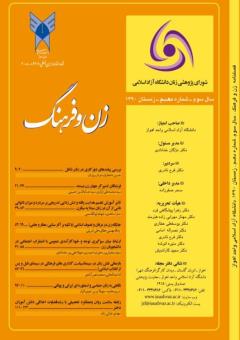رابطه سلامت روان وعملکرد تحصیلی با رشدقضاوت اخلاقی دانش آموزان دختر
محورهای موضوعی : روان شناسی
1 - دانشگاه آزاد اسلامی ، واحد اهواز،گروه روان شناسی عمومی، اهواز، ایران
کلید واژه: سلامت روان, mental health, Academic Performance, عملکرد تحصیلی, رشد قضاوت اخلاقی, Moral judgment development,
چکیده مقاله :
هدف پژوهش حاضر بررسی رابطه سلامت روانی وعملکرد تحصیلی بارشدقضاوت اخلاقی دانش آموزان دختر دوره راهنمایی شهرستان ملکشاهی است. بدین منظور از میان کلیه دانش آموزان دخترمقطع تحصیلی سوم راهنمایی شهرستان ملکشاهی که در سال تحصیلی 90-89 مشغول به تحصیل بوده، تعداد140نفر به شیوه نمونه گیری خوشه ای انتخاب گردید.جهت جمع آوری داده ها از پرسشنامه سلامت روانی(SCL25) ، پرسشنامه فرم کوتاه رشد قضاوت اخلاقی(DIT) و معدل نیمسال اول تحصیلی به عنوان سنجش عملکرد تحصیلی استفاده شد. نتایج حاصل از تحلیل رگرسیون چند متغیری نشان داد که حدود 20% واریانس متغیر رشد قضاوت اخلاقی توسط متغیرهای پیش بین سلامت روان و عملکرد تحصیلی قابل پیش بینی می باشد.
The aim of this research was to investigate the relationship between mental health and academic performance with moral judgment development in female students in Malekshahy girl secondary schools. The sample included 140 female students which were selected by cluster sampling method. The instruments were Symptom Check List (SCL-25) and Short Form Development of Moral Judgments Questionnaire (DIT).Their first semester average scores of the educational year was used as an indicator of scholastic performance .In order to analysis the data, Pearson correlation coefficient and multivariate regression methods were used. The results indicated that there was a negative significant correlation between mental health and moral judgment growth, while mental health and academic performance significantly positive correlated to moral judgment development.
افشاری، علی (1385). نگاهی به نقش وتأثیر شکست تربیتی وشکست تحصیلی، نشریه پیوند شماره328، وزارت آموزش وپرورش تهران: انتشارات انجمن اولیاء ومربیان
برک، لورا ای. (2001). روان شناسی رشد (از نوجوانی تا پایان زندگی). ترجمه یحیی سیدمحمدی. (1382). تهران: انتشارات ارسباران. جلد اول و دوم.
ساپینگتون، (1989)،سلامت روانی. ترجه حسین شاهی برواتی، 1385، صفحه 1
سازمان بهداشت جهانی، (1990)، ترجمه شاه محمدی؛ باقری؛ و پالاهنگ، به نقل از سلطانیان و همکاران، 1383، صفحه 174
سلحشور،ماندانا(1382)الفبای بهداشت روانی ،نشریه پیوند،شماره291،صفحه40-41
کدیور، پروین. (1385). روانشناسی تربیتی، تهران: انتشارات سمت
میلانی فر، بهروز (1382). بهداشت روانی (ویرایش سوم). تهران: نشر قومس.
فرید،ابوالفضل؛ سعدی پور، اسماعیل ؛کریمی، یوسف وفلسفی نژاد، محمدرضا(1389). اثربخشی روش های آموزش مستقیم، آموزش شناختی اخلاق، شفاف سازی ارزش ها وتلفیقی بر قضاوت اخلاقی دانش آموزان. فصلنامه علمی- پژوهشی روانشناسی دانشگاه تبریز، سال پنجم. شماره 19.
وردی ، مینا(1380)رابطه کمال گرایی وسرسختی روانشناختی با سلامت روانی وعملکرد تحصیلی در دانش آموزان دختر مرکز پیش دانشگاهی اهواز،پایان نامه کارشناسی ارشد روان شناسی عمومی،دانشگاه شهید چمران اهواز،دانشکده علوم تربیتی وروانشناختی
Berger, K.S.(2001).The developing person through the life span. New York: Worth Publishers.
Damon. W,& Hart. D. (1988). Self-understanding in child hood and adolescence.New York:Cambridge University Press.
Damon. W,& Hart. D. (1992). Self-understanding and its role in socisl and moral development.In M. H. Bornstein &M. E. Lamb (Eds.),Developmental psychology:An advanced textbook (pp.421-464). Hillsdale.NJ:Lawrence Erlbaum
Fabes, R.A., Carlo, G., Kupanoff, K., & Laible, D.(1999).Early adolescence and prosocial/ moral behaviore: The role of individual processes. Journal of Early Adolescence,19,5-16.
Farrer, F. (2000).A Quiet Revaluation.The work of west kidlington School London,Rider.
Gert, B. (2005). The Definition of Morality,"The Stanford Encyclopedia of philosophy Fall (2005 Edition),Edward N.zalta(Ed)UrL.
Gert,Bemard (1998). Morality: A new justification of the moral rules.New York: Oxford University Press.
Gilligan, C. (1982).In a different voice: Psycological theory and women's development. Cambridge,MA:Harvard University Press.
Gilligan, C. (1990).Moral development beyond adolescence. In Charles N.Alexander & Ellen, J.Langer (Eds), Higher stages of human development. New York: Oxford University Press.
-Jadack, R. A., Hyde, J. S., Moore, C. F., & Keller, M. L. (1995).Moral reasoning about sexually transmitted diseases. Childs development,66,167-177.
Kazarin, S.S., Events, D.R. (2001). Health psychology and culture: embracing the 21st century. Handbook of cultural health psychology. Academic press.
Kohlberg, L &Gilligan, C. (1971). The adolescent as a philosopher:The discovery of the self in a post-conventional world.Daedalus,100,1051-1086.
Kohlberg. L (1958) The development of modes of moral thinking and choice in the years 10 to 16.Unpublished doctoral dissertation,University of Chicago.
Kohlberg. L. (1969).Stage and sequence:The cognitive-developmental approach to socialization theory and research,Chicago:Rand McNally.
Kohlberg. L. (1976). Moral stages and moralization: The cognitive- development approach. In T. Lickona(Ed). Moral development and behavior.New York:Holt,Rinchart&Winston.
Narvaez, Darcia. (2008). Triune Ethics: The Neurological Roots of Our Multiple Moralities, New Ideas in Psychology 26, 95-119
Piaget,Jean (1932). The moral judgement of the child. New York:Harcourt.
Piaget.Jean (1950). The moral of the child. London:Routledge and Kegan paul.
Rest, Jams R., Narvaez, Darcia, Toma, Stephen. J., Be Beau, Muriel. (2000). A Neo-kohlbergian Approach to Morality Research, Journal of Moral Education, Vol. 29, No. 4.
Rest, Jams. R., Toma, Stephen. J., Narvaez, Darcia, Be beau, Muriel. J. (1997). Alchemy and Beyond: Indexing the Defining Issues Test, Journal of Educational Psychology, Vol .89, No, 3, 498-507.
Shaffer,j.w.(2001).Developmental psychology:Childhood and adolescence. Fourth Edition.Boston:Brooks/cole
Smith, P.K., Cowie, H., & Blades, J. (1998). Under-Standing childerns development.U.S.A:Blackwell Publishers.
_||_

